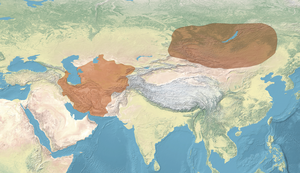
Back الغزو المغولي للدولة الخوارزمية Arabic Monqolların Xarəzmə yürüşü Azerbaijani موغوللارین خارزمه یوروشو AZB Мангольскае заваяванне Харэзма Byelorussian Invasió mongola de Khwarezm Catalan Invasionen af Khwarezmia Danish Mongolaj invadoj de Ĥorezmo Esperanto Invasión mongola de Corasmia Spanish حمله مغول به امپراتوری خوارزمشاهیان Persian Mongolien hyökkäykset Kovaresmiaan Finnish
| Mongol conquest of Khwarezmia | |||||||||
|---|---|---|---|---|---|---|---|---|---|
| Part of the Mongol invasion of Central Asia and the Mongol invasion of Persia and Mesopotamia | |||||||||
The Khwarazmian Empire and the Mongol homeland in continental Asia c. 1215, five years before the Mongol invasion | |||||||||
| |||||||||
| Belligerents | |||||||||
| Mongol Empire | Khwarazmian Empire | ||||||||
| Commanders and leaders | |||||||||
| Units involved | |||||||||
| Predominantly city garrisons | ||||||||
| Strength | |||||||||
|
Disputed (see below). Estimates include:
|
Disputed (see below). Estimates include:
| ||||||||
| Casualties and losses | |||||||||
| Unknown | Possibly as high as 10–15 million people[1] | ||||||||
Between 1219 and 1221,[2] the Mongol forces under Genghis Khan invaded the lands of the Khwarazmian Empire in Central Asia. The campaign, which followed the annexation of the Qara Khitai Khanate, saw widespread devastation and atrocities. The invasion marked the completion of the Mongol conquest of Central Asia, and began the Mongol conquest of Persia.
Both belligerents, although large, had been formed recently: the Khwarazmian dynasty had expanded from their homeland to replace the Seljuk Empire in the late 1100s and early 1200s; nearly simultaneously, Genghis Khan had unified the Mongolic peoples and conquered the Western Xia dynasty. Although relations were initially cordial, Genghis was angered by a series of diplomatic provocations. When a senior Mongol diplomat was executed by Khwarazmshah Muhammed II, the Khan mobilized his forces, estimated to be between 90,000 and 200,000 men, and invaded. The Shah's forces were widely dispersed and probably outnumbered—realizing his disadvantage, he decided to garrison his cities individually to bog the Mongols down. However, through excellent organization and planning, they were able to isolate and conquer the Transoxianan cities of Bukhara, Samarkand, and Gurganj. Genghis and his youngest son Tolui then laid waste to Khorasan, destroying Herat, Nishapur, and Merv, three of the largest cities in the world. Meanwhile, Muhammed II was forced into flight by the Mongol generals Subutai and Jebe; unable to reach any bastions of support, he died destitute on an island in the Caspian Sea. His son and heir Jalal-al Din managed to mobilize substantial forces, defeating a Mongol general at the Battle of Parwan, but these were crushed by Genghis at the Battle of the Indus a few months later.
After clearing up any remaining resistance, Genghis returned to his war against the Jin dynasty in 1223. The war was one of the bloodiest in human history, with total casualties estimated to be between two and fifteen million people. The subjugation of the Khwarazmian lands provided a base for the Mongols' later assaults on Georgia and the rest of Persia; when the empire later divided into separate khanates, the Persian lands formerly ruled by the Khwarazmids would be governed by the Ilkhanate, while the northern cities would be ruled by the Chagatai Khanate. The campaign, which saw the Mongols engage and defeat a non-sinicized state for the first time, was a pivotal moment in the growth of the Mongol Empire.
- ^ Ward, Steven R. (2009). Immortal: A Military History of Iran and Its Armed Forces. Georgetown University Press. p. 39. ISBN 978-1-58901-587-6. Archived from the original on May 12, 2024.
Overall, the Mongol violence and depredations killed up to three-fourths of the population of the Iranian Plateau, possibly ten to fifteen million people.
- ^ May, Timothy (2016). The Mongol Empire: A Historical Encyclopedia. Santa-Barbara, CA: ABС-СLIO. p. 162.
...he (Genghis Khan) led his main army over 1,000 miles to invade the Khwarazmian Empire in 1219. Within two years, a once dynamic and powerful empire has been erased from the map and largely forgotten in history.
© MMXXIII Rich X Search. We shall prevail. All rights reserved. Rich X Search

